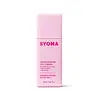What's inside
What's inside
 Key Ingredients
Key Ingredients

 Benefits
Benefits

 Concerns
Concerns

 Ingredients Side-by-side
Ingredients Side-by-side

Water
Skin ConditioningHydrogenated Poly(C6-14 Olefin)
EmollientCaprylic/Capric Triglyceride
MaskingDimethicone
EmollientGlycerin
HumectantButylene Glycol
HumectantCetearyl Olivate
Sorbitan Olivate
EmulsifyingCyclopentasiloxane
Emollient1,2-Hexanediol
Skin ConditioningAscorbyl Palmitate
AntioxidantCaprylyl Glycol
EmollientCetearyl Alcohol
EmollientCetearyl Methicone
Skin ConditioningCitric Acid
BufferingGlyceryl Stearate
EmollientHydrolyzed Hyaluronic Acid
HumectantIsohexadecane
EmollientIsopropyl Lauroyl Sarcosinate
Skin ConditioningLeuconostoc/Radish Root Ferment Filtrate
AntimicrobialLinoleic Acid
CleansingLycopene
AntioxidantMarrubium Vulgare Extract
Skin ConditioningOlea Europaea Fruit Oil
MaskingPEG-100 Stearate
PEG-40 Stearate
EmulsifyingPhenoxyethanol
PreservativePhospholipids
Skin ConditioningPolymethylsilsesquioxane
Retinyl Palmitate
Skin ConditioningSodium Benzoate
MaskingSodium Polyacrylate
AbsorbentSteareth-2
EmulsifyingSteareth-21
CleansingTocopheryl Acetate
AntioxidantWater, Hydrogenated Poly(C6-14 Olefin), Caprylic/Capric Triglyceride, Dimethicone, Glycerin, Butylene Glycol, Cetearyl Olivate, Sorbitan Olivate, Cyclopentasiloxane, 1,2-Hexanediol, Ascorbyl Palmitate, Caprylyl Glycol, Cetearyl Alcohol, Cetearyl Methicone, Citric Acid, Glyceryl Stearate, Hydrolyzed Hyaluronic Acid, Isohexadecane, Isopropyl Lauroyl Sarcosinate, Leuconostoc/Radish Root Ferment Filtrate, Linoleic Acid, Lycopene, Marrubium Vulgare Extract, Olea Europaea Fruit Oil, PEG-100 Stearate, PEG-40 Stearate, Phenoxyethanol, Phospholipids, Polymethylsilsesquioxane, Retinyl Palmitate, Sodium Benzoate, Sodium Polyacrylate, Steareth-2, Steareth-21, Tocopheryl Acetate
Water
Skin ConditioningGlycerin
HumectantCaprylic/Capric Triglyceride
MaskingPentaerythrityl Tetraethylhexanoate
EmollientNiacinamide
SmoothingCeramide NP
Skin ConditioningCholesterol
EmollientPhytosphingosine
Skin ConditioningPolyglyceryl-3 Methylglucose Distearate
EmulsifyingStearic Acid
CleansingOleic Acid
EmollientLactic Acid
BufferingTromethamine
BufferingCamellia Sinensis Leaf Extract
AntimicrobialHydroxyacetophenone
AntioxidantCetearyl Alcohol
EmollientCarbomer
Emulsion StabilisingXanthan Gum
Emulsifying1,2-Hexanediol
Skin ConditioningWater, Glycerin, Caprylic/Capric Triglyceride, Pentaerythrityl Tetraethylhexanoate, Niacinamide, Ceramide NP, Cholesterol, Phytosphingosine, Polyglyceryl-3 Methylglucose Distearate, Stearic Acid, Oleic Acid, Lactic Acid, Tromethamine, Camellia Sinensis Leaf Extract, Hydroxyacetophenone, Cetearyl Alcohol, Carbomer, Xanthan Gum, 1,2-Hexanediol
 Reviews
Reviews

Ingredients Explained
These ingredients are found in both products.
Ingredients higher up in an ingredient list are typically present in a larger amount.
1,2-Hexanediol is a synthetic liquid and another multi-functional powerhouse.
It is a:
- Humectant, drawing moisture into the skin
- Emollient, helping to soften skin
- Solvent, dispersing and stabilizing formulas
- Preservative booster, enhancing the antimicrobial activity of other preservatives
This ingredient is an emollient, solvent, and texture enhancer. It is considered a skin-softener by helping the skin prevent moisture loss.
It helps thicken a product's formula and makes it easier to spread by dissolving clumping compounds.
Caprylic Triglyceride is made by combining glycerin with coconut oil, forming a clear liquid.
While there is an assumption Caprylic Triglyceride can clog pores due to it being derived from coconut oil, there is no research supporting this.
Learn more about Caprylic/Capric TriglycerideCetearyl alcohol is a mixture of two fatty alcohols: cetyl alcohol and stearyl alcohol. It is mainly used as an emulsifier. Emulsifiers help prevent the separation of oils and products. Due to its composition, it can also be used to thicken a product or help create foam.
Cetearyl alcohol is an emollient. Emollients help soothe and hydrate the skin by trapping moisture.
Studies show Cetearyl alcohol is non-toxic and non-irritating. The FDA allows products labeled "alcohol-free" to have fatty alcohols.
This ingredient is usually derived from plant oils such as palm, vegetable, or coconut oils. There is debate on whether this ingredient will cause acne.
Due to the fatty acid base, this ingredient may not be Malassezia folliculitis safe.
Learn more about Cetearyl AlcoholGlycerin is already naturally found in your skin. It helps moisturize and protect your skin.
A study from 2016 found glycerin to be more effective as a humectant than AHAs and hyaluronic acid.
As a humectant, it helps the skin stay hydrated by pulling moisture to your skin. The low molecular weight of glycerin allows it to pull moisture into the deeper layers of your skin.
Hydrated skin improves your skin barrier; Your skin barrier helps protect against irritants and bacteria.
Glycerin has also been found to have antimicrobial and antiviral properties. Due to these properties, glycerin is often used in wound and burn treatments.
In cosmetics, glycerin is usually derived from plants such as soybean or palm. However, it can also be sourced from animals, such as tallow or animal fat.
This ingredient is organic, colorless, odorless, and non-toxic.
Glycerin is the name for this ingredient in American English. British English uses Glycerol/Glycerine.
Learn more about GlycerinWater. It's the most common cosmetic ingredient of all. You'll usually see it at the top of ingredient lists, meaning that it makes up the largest part of the product.
So why is it so popular? Water most often acts as a solvent - this means that it helps dissolve other ingredients into the formulation.
You'll also recognize water as that liquid we all need to stay alive. If you see this, drink a glass of water. Stay hydrated!
Learn more about Water